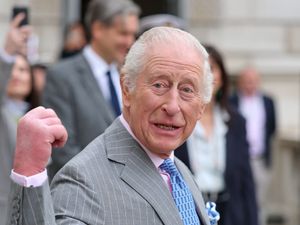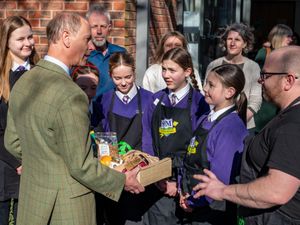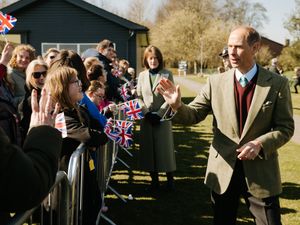What's on the Queen's coffin: The crown, flag and flowers used for funeral service
The Queen will be separated from her crown for the last time today when she's laid to rest at Windsor Castle.
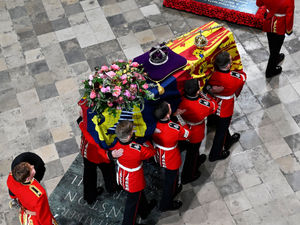
For the last few days her coffin has been adorned with the Crown Jewels, the Royal Standard flag and flowers.
Members of the armed forces have carried Her Majesty's coffin to to the funeral service at Westminster Abbey, as well as various other ceremonies during the last week.
Who carried the Queen's coffin?
The coffin bearers at both Westminster Abbey and Windsor Abbey are from a unit of which Queen Elizabeth was Company Commander.
Soldiers from the Queen’s Company, 1st Battalion Grenadier Guards, have been chosen to lift the coffin. The former sovereign’s connection with her men was strong, although a senior officer took day-to-day control.
The Queen’s Company will retain its name up until the monarch is laid to rest, and will later change to reflect the new King.
Former British Army soldier Major Adrian Weale told the PA news agency: “They became the Queen’s Company immediately after the death of George VI and the Queen has been commander ever since.
“It’s their role to protect her body, both in life and in death, remaining the Queen’s Company until King Charles decides otherwise. Their duties will then be transitioned to the next monarch.”
Flowers on the Queen's coffin
The wreath adorning the Queen’s coffin includes flowers requested by King Charles.
Cut from the gardens of Buckingham Palace, Clarence House and Highgrove House, the flowers and foliage have been chosen for their symbolism.
They include rosemary, for remembrance, and myrtle cut from a plant which was grown from a sprig of myrtle in the Queen’s wedding bouquet. Myrtle is often seen as a symbol of a happy marriage.
Also included are English oak to symbolise the strength of love, pelargoniums, garden roses, autumnal hydrangea, sedum, dahlias and scabious.
These are in shades of gold, pink and deep burgundy, with touches of white, to reflect the Royal Standard.
Also at the King’s request, the wreath has been made in a sustainable way, in a nest of English moss and oak branches.
No use of floral foam has been used.
In a personal touch, the wreath adorning the Queen’s coffin had a handwritten note, which was penned by the King.
The message said: “In loving and devoted memory.”
Flag on the Queen's coffin
The Royal Standard adorns the coffin for the funeral, as it has done during the lying-in-state at Westminster Hall. It's a flag that represents the sovereign and the United Kingdom.
It is flown when the monarch is in residence in one of the Royal Palaces, on their car car on official journeys and on aircraft (when on the ground).
It may also be flown on any building, official or private (but not ecclesiastical buildings), during a visit by the monarch, if the owner or proprietor so requests.
The composition of the Royal Standard has taken various forms over the past four centuries since the Union of the Crowns in 1603. Today's Standard contains four quarterings - England (three lions passant) in the first and fourth quarters, Scotland (a lion rampant) in the second quarter and Ireland (a harp) in the third quarter.
Wales is not represented as its special position as a Principality was recognised by the creation of the Prince of Wales long before the incorporation of the quarterings for Scotland and Ireland in the Royal Arms.
In Scotland a different version of the Royal Standard is used, with Scottish arms in the first and fourth quarters and English arms in the second.
Later on at Windsor Castle, Major Johnny Hathaway-White, 36, from Wiltshire, will lay the Camp Colour of the Captain of the Queen’s Company - a regimental flag - at the foot of her coffin after it is placed onto a catafalque – a raised platform.
It had been at the Regimental Headquarters of the Grenadier Guards being prepared.
The colour was presented to the Grenadier Guards by the sovereign after the Queen became the monarch, and it was only paraded in her presence and has never been changed or replaced.
On the day the Queen died, the unit was deployed on operations in Iraq, and was returned from operations.
Crown on the Queen's coffin
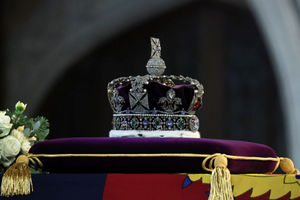
On a purple velvet cushion sits the Imperial State Crown, which is possibly the most familiar item in the Crown Jewels.
The priceless crown sparkles with nearly 3,000 stones - including 2,868 diamonds, 269 pearls, 17 sapphires, 11 emeralds, and four rubies. It contains some of the Crown Jewels’ most famous pieces including the Black Prince’s Ruby, the Stuart Sapphire, and the Cullinan II diamond.
The Queen wore the crown when she left Westminster Abbey after her coronation in 1953, as well as at other State occasions, including the State Opening of Parliament.
In a BBC documentary in 2018 about her coronation, the Queen amused viewers by manhandling the heavy crown, pulling it towards her, turning it round and declaring: “This is what I do when I wear it.”
“I like the Black Prince’s Ruby,” she added.
The Orb and and Sceptre - held by the monarch at their coronation - also adorn the Queen's coffin.
The Imperial State Crown, the orb and the sceptre will be lifted from the Queen’s coffin by the Crown Jeweller during the 4pm committal service at St George's Chapel, Windsor Castle. The Crown Jewels will then be passed to the Dean of Windsor who will place them on the High Altar.

